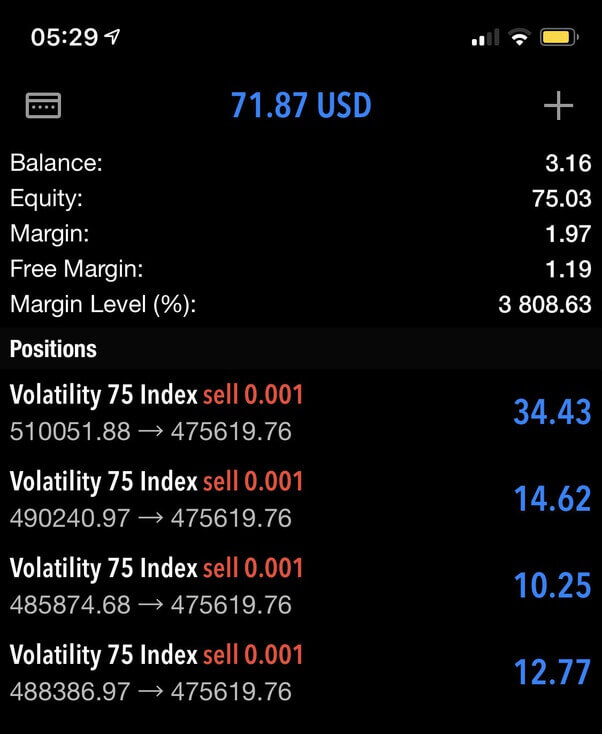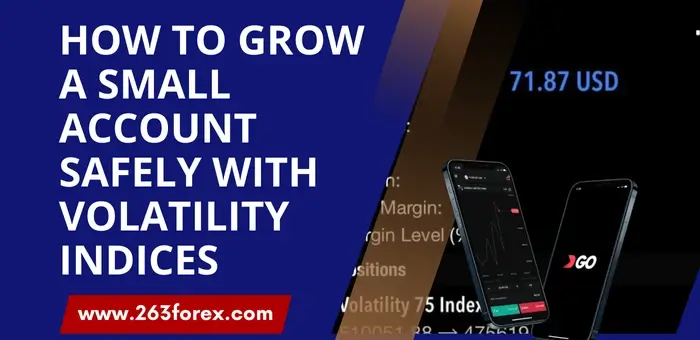👋 My Experience Starting Small on V75
When I started trading volatility indices, I was drawn to their 24/7 movement and crazy fast price action — especially Volatility 75 (V75). But like many beginners, I blew several small accounts trying to flip $10 into $100 overnight.
The problem wasn’t the market. It was me — no proper lot sizing, no stop loss, and no understanding of the index I was trading. If you’re just getting started with $5, $10, or even $30, this guide will help you grow that account slowly, safely, and smartly.
🎯 Can You Trade Volatility Indices with $10?
Yes — but you need to be extra strategic. Unlike Boom & Crash, volatility indices don’t spike in one direction. They flow more like real markets, so reading structure is key.
Here are a few realities of trading small on V75, V25, or V100:
- You must stick to 0.001 lots
- You need stop losses — always
- You only have margin for 1 trade at a time
- You’re not here to get rich in a day — you’re here to survive and learn
🔑 1. Choose the Right Index for Your Equity
For small accounts, not all volatility indices are equal.
✅ Best Options:
| Index | Why It’s Safer |
|---|---|
| Volatility 25 (1s) | Smaller price moves, less margin |
| Volatility 10 (1s) | Very stable, ideal for low-risk setups |
| Volatility 75 (1s) | Popular, but use small SL to survive |
| Volatility 50 | Balanced movement with decent volatility |
⚠️ Avoid high volatility monsters like V150 (1s), V300 (1s) or Range Break 100 unless you’re confident in your edge.
💡 If you’re unsure which indices are aggressive and which are calmer:
- 🔥 Read: Most Volatile Synthetic Indices on Deriv
- 🧊 Also Read: Least Volatile Synthetic Indices on Deriv
These guides will help you match your equity with the right instrument.

⚖️ 2. Use the Correct Lot Size + SL Combo
If you’re using $10 and trading 0.001 lot:
- SL = 40,000 points (~$0.40)
- TP = 120,000 points (~$1.20)
💡This gives you a 1:3 risk-reward ratio. Even if you win 1 out of 3 trades, you’re breaking even.
Stick to this. Don’t try to scale up until you double your account.
📈 3. Focus on High-Probability Zones
Zoom out to M15 or H1 and mark:
- Recent highs/lows
- Support and resistance
- Clean engulfing or breakout structures
Wait for price to reject those levels, then drop to M1 or M5 for confirmation.
✅ No setup = no trade. That’s how small accounts grow.

🔁 4. Trade 1 Signal Per Day, Not 10
One clean V75 setup with 3:1 R:R can do more for your $10 account than 10 random scalps. Don’t be addicted to chart time — be addicted to good trades.
💡 If the market looks choppy, skip the day. No trade is better than a rushed loss.
📓 5. Journal Every Trade
Write down:
- The index
- The setup
- Entry & exit prices
- SL/TP
- What went wrong or right
This habit alone will 2x your growth. You’ll learn faster, avoid repeating mistakes, and recognize which index fits your style.

🧠 Remember these Tips for Small Account Traders
- Start on demo, but treat it like real money
- Withdraw part of your profits after every double
- Never open more than 1 position unless you’re 100% sure
- Avoid revenge trading — small accounts can’t recover easily
🧠 Final Thoughts (and a Real Example)
Here’s proof that small account growth is possible — the screenshot below shows a real trade session with over $70 in profit from just $3 starting balance, using 0.001 lot size on V75.
But let me be clear: this didn’t happen by luck or random clicking. It came from waiting for the right setup, logging every trade, and following strict rules.
Most traders lose money because they:
- Open too many trades at once
- Don’t have a strategy
- Try to flip accounts emotionally without structure
If you’re serious about growing your account, start journaling, stay disciplined, and avoid revenge trading. Let every dollar work with intention.
You don’t need 10 trades a day. You just need 1 good one with a plan.

🔗 Related Guides

FAQs On How To Grow A Small Account Using Volatility Indices
Yes, but only at 0.001 lot with tight stops. Don’t chase breakouts or hold trades overnight.
Volatility 25 (1s) or Volatility 10 (1s) are safer and use less margin. V75 (1s) is doable, but requires precision.
Start with M15/H1 for structure, then drop to M1/M5 for entries. Avoid overtrading on low timeframes.
Simple tools like RSI or EMAs can help confirm your entries, but don’t rely on them alone.
If you’re consistent, you can flip $10 into $50–$100 within weeks — but only with strict risk control and discipline.





Other Posts You May Be Interested In
Experience-Based Profitable Tips for Trading Synthetic Indices 📊💰
📅 Last updated: May 6, 2025 ✍️ Written by: Jafar Omar ✅ Fact-checked by: Munyaradzi [...]
Deriv Dex Indices Explained, Learn To Trade Them Profitably 💹
📅 Last updated: May 4, 2025 ✍️ Written by: Jafar Omar ✅ Fact-checked by: Munyaradzi [...]
FBS Review 2024 🔍 Is It A Good Broker?
📅 Last updated: June 1, 2024 ✍️ Written by: Jafar Omar ✅ Fact-checked by: Munyaradzi [...]
Exness Review 2024: 🔍 Is This Forex Broker Legit & Reliable?
📅 Last updated: May 29, 2024 ✍️ Written by: Jafar Omar ✅ Fact-checked by: Munyaradzi [...]
Deriv Copy Trading Review (2025): Is cTrader Worth It? ♻️
📅 Last updated: May 20, 2025 ✍️ Written by: Jafar Omar ✅ Fact-checked by: Munyaradzi [...]
Volatility Indices on Deriv: Complete Traders Guide (2025) 💹
📅 Last updated: May 7, 2025 ✍️ Written by: Jafar Omar ✅ Fact-checked by: Munyaradzi [...]